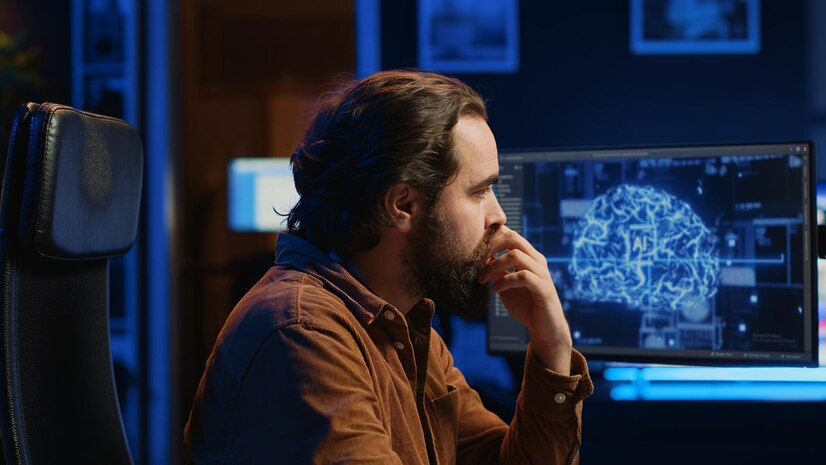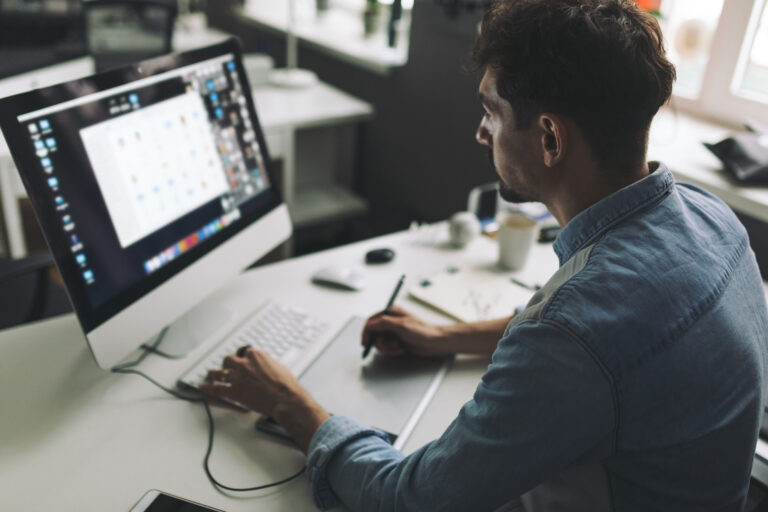The field of graphic design is constantly changing, and artificial intelligence (AI) is becoming a powerful influence. AI is changing the way designers work and the design process as a whole because of its capacity to automate activities, produce original content, and analyze enormous volumes of data. But like with every technical development, there are advantages and disadvantages to AI in graphic design.
Is AI a friend that fosters creativity and efficiency or an adversary that undermines the conventional knowledge and employment opportunities for graphic designers? We’ll examine the complex effects of AI on graphic design in New York in this blog, offering analysis, data, and insights to help readers better grasp this dynamic relationship.

The Rise of AI in Graphic Design
The impact of AI on graphic design has increased dramatically in the last several years. The global market of AI in graphic design was estimated to be worth $1.2 billion in 2023, and from 2024 to 2030, it is projected to expand at a compound annual growth rate (CAGR) of 29.2%, according to a report by Grand View Research. This quick expansion is a reflection of how designers and design agencies are using AI tools more and more. Natural language processing, neural networks, machine learning algorithms, and other tools and technologies make it easier for AI to be integrated into visual design. AI is now able to do things like coming up with design ideas, automating tedious chores, and even producing original design content thanks to these technologies.
AI as a Friend in Graphic Design

1. Enhanced Creativity and Efficiency
Graphic designers are now much more creative and productive thanks to AI tools. AI is used by platforms such as Adobe Sensei to monitor design trends and offer intelligent recommendations, allowing designers to swiftly produce visually appealing and trend-right designs. AI-powered solutions, according to Adobe, can cut down on design time by as much as 50%, freeing up designers to concentrate more on creative rather than menial chores. AI is also useful in the generation of prototypes and design concepts. AI is used, for instance, by programs like Canva’s Magic Resize to automatically resize and format design elements for various formats and sizes, saving designers hours of laborious human labor.
Automating tedious activities is one of AI’s most important benefits for graphic designers. Color correction, background removal, and image resizing are examples of laborious, time-consuming tasks. These jobs may be completed fast and precisely by AI-powered tools like Luminar AI and Remove.bg, freeing up designers to concentrate on more intricate and imaginative elements of their work. According to a McKinsey & Company study, automation in design processes can boost output by as much as 40%, demonstrating AI’s ability to improve productivity and optimize workflows.
3. Data-Driven Design Insights
AI has completely changed the way designers approach their work by being able to analyze massive datasets and extract insightful information. The solutions o AI in graphic design are able to deliver data-driven recommendations by analyzing market trends, design performance, and user behavior. To assist designers make wise judgments and produce designs that appeal to their target audience, tools such as Google Analytics and Hotjar, for instance, provide insights on how people interact with design aspects. Forrester Research indicates that data-driven design can result in a 25% rise in conversion rates and a 30% increase in user engagement, illustrating the influence of AI-driven insights on design efficacy.
4. Personalization and Customization
AI gives designers the ability to give people extremely tailored and individualized experiences. AI tools may produce design features that are specific to each user by examining their preferences, behavior, and demographics. For instance, based on a user’s browsing history and interests, AI-powered recommendation engines on e-commerce platforms might provide customized product designs.
According to a Gartner survey, 72% of consumers want personalized experiences from brands, highlighting the significance of artificial intelligence in providing customized design solutions.
AI as a Foe in Graphic Design

1. Threat to Traditional Skills and Jobs
Although AI has many advantages, there are worries that it could replace traditional design professions and talents. There is concern that as AI tools develop, human designers may eventually be replaced by them, especially in jobs that need repetitive and routine work. Up to 47% of jobs in the creative sector may be at risk of automation in the next ten years, according to a report by Oxford Economics. This includes jobs like junior designers and graphic design assistants, who might experience more competition from AI-powered tools.
2. Over-Reliance on AI Tools
The possible over-reliance on AI technologies, which could result in the loss of essential design skills, is another problem. Designers run the risk of losing proficiency in manual design processes as they depend more and more on AI for tasks like layout and color correction. According to a Design Week survey, 62% of designers worry that an excessive dependence on AI tools could cause them to lose their creative edge. It’s imperative to strike a balance between traditional design abilities and AI support in order to preserve designers’ knowledge and creativity.
3. Quality Control and Ethical Concerns
AI-generated designs might not always live up to the ethical and quality standards that consumers and clients demand. Based on the data they are trained on, artificial intelligence (AI) algorithms may generate designs that are biased or lack creativity. For example, prejudices or stereotypes that are present in training datasets may unintentionally be reinforced by AI systems. The AI Now Institute has released a research that emphasizes the necessity of ethical concerns in AI design processes. The report also stresses the significance of human oversight in ensuring that AI-generated designs are both ethically sound and of high quality.
The Role of AI in New York’s Graphic Design Landscape
The AI in graphic design influences especially noticeable in New York. New York is a key center for design and innovation, and many experts and design organizations there are using AI technologies to improve their services. Leading New York-based graphic design, Digital agencies are pioneer in using AI into design workflows. They provides a variety of graphic design services in New York, such as branding, logo creation, and marketing collateral, by utilizing AI tools. By integrating AI, the firm may differentiate itself in a competitive market by providing its clients with high-quality, efficient, and data-driven design solutions.

Balancing AI and Human Creativity
Finding a balance between artificial intelligence (AI) and human creativity is crucial to fully utilizing its advantages in graphic design, even if AI brings both opportunities and obstacles. AI ought to be seen as an instrument to supplement human design expertise, not as a substitute for it. Through the adoption of AI’s capabilities and their seamless integration into their processes, designers can enhance productivity, innovation, and customization.
Designers must simultaneously keep refining their conventional techniques while keeping a watchful eye on the moral ramifications of AI-generated creations. In order to produce creative and powerful visual content, AI and human designers will probably collaborate in the future of graphic design.

Conclusion
The use of AI in graphic design is a complicated and developing field. AI poses issues with traditional skills, job displacement, and ethical concerns, even while it has enormous benefits in terms of creativity, efficiency, and data-driven insights. Designers and design companies can use AI to improve their work and maintain their competitiveness in the always evolving design industry by comprehending and resolving these dynamics.
The link between technology and design will probably get more complex as AI develops, opening up new avenues for creativity and possibilities. Whether AI is viewed as a friend or a threat, there is no denying its influence on AI in graphic design, and its potential to shape the field’s future will no doubt be the subject of continued research and debate.
Stay ahead with the latest tech trends, tutorials, and innovation at InnovatTechie.co – connect with us for exclusive updates! Get In Touch


1 Comment
I am extremely impressed with your writing skills as smartly as with the layout on your blog.
Is this a paid subject or did you customize it yourself?
Anyway keep up the excellent quality writing, it is
uncommon to see a great weblog like this one today.